The NVIDIA GeForce GTX 750 Ti and GTX 750 Review: Maxwell Makes Its Move
by Ryan Smith & Ganesh T S on February 18, 2014 9:00 AM ESTMeet The Reference GTX 750 Ti & Zotac GTX 750 Series
For the launch of the GTX 750 series NVIDIA is doing a pure virtual launch. NVIDIA’s partners will be launching with custom cards from day-one, and while NVIDIA has put together a reference board for testing and validation purposes, the partners will not be selling that reference board. Instead we’ll be seeing semi-custom and fully-custom designs; everyone has their own cooler, a lot of partners will be using the NVIDIA reference PCB, and others will be rolling out their own PCBs too. Since these are sub-75W/sub-$150 cards there’s not a lot of room for variation – expect single and dual fan open air coolers – but we’ll have to see just what the partners cook up. GM107 should be suitable for fully passive designs and low-profile designs, and while we’ve seen one low-profile design so far we haven’t seen any passive designs yet.
Meanwhile for the purposes of the GTX 750 Ti launch NVIDIA has seeded the press with the GTX 750 Ti reference board for evaluation purposes. They have not seeded the press with GTX 750 boards, so we’ll be looking at a retail board in that scenario.
Reference GeForce GTX 750 Ti
The reference GeForce GTX 750 Ti is fairly typical of what retail boards will be like. NVIDIA’s cooler of choice on the reference GTX 750 Ti is a small but effective open air double-wide cooler. NVIDIA’s using a low-profile aluminum heatsink that covers roughly half the card, topped with a 55mm fan. This is the cooler style that most partners will mimic, as the 60W TDP of the GTX 750 Ti does not require a particularly large cooler. As is common with open air coolers, the heatsink itself doesn’t make contact with the on-board RAM, so RAM cooling is left to airflow coming off of the fan.
NVIDIA’s RAM of choice for the GTX 750 Ti is their traditional favorite, Hynix 6GHz GDDR5, with NVIDIA using Hynix’s new 4Gb modules to get 2GB with just 4 modules. The use of 6GHz RAM, which will be common across this product, means that the GTX 750 Ti will have some memory overclocking headroom right out of the box, memory bus willing. NVIDIA uses 4 pieces of it in a 4x32bit configuration, with 4 more pads on the back of the card for another 4 pieces for 4GB cards should the need arise.
Moving on, the PCB itself is largely lifted from the GTX 650 and GTX 650 Ti, the similar TDPs allowing partners to get their customized cards out right away, and indicating that GM107 doesn’t have significantly different I/O or power delivery requirements than GK107. This puts the length of the card at 5.75” – about as short as a PCIe x16 card can be – in a full-profile form factor. There is a spot on the board for a PCIe power socket, and while it’s not used nor necessary on the reference design, this does leave the door open to more aggressive overclocking designs on partner cards.
Finally, display connectivity is provided by 1 DL-DVI-I port, 1 DL-DVI-D port, and a mini-HDMI port. Since Maxwell GPUs support 4 displays the GTX 750 Ti can drive up to 3 displays via these connectors in any combination and configuration. The lack of a DisplayPort is disappointing, but not surprising. With most partners opting for 2x DVI and 1x mini-HDMI on their GTX 650 series cards, the PCB reuse means the GTX 750 Ti launch cards will be of a similar makeup. As a result we will see some DisplayPort enabled cards, and we wouldn’t be surprised if this shifted a bit over the coming months as partners move inventory and can take the time to do more customization to their designs. NVIDIA’s G-Sync technology would be a good match for these cards given the lower framerates we typically see, so having DisplayPort connectivity here will be important for NVIDIA’s G-Sync initiative as the first native G-Sync monitors hit the market later this year.
Zotac GeForce GTX 750 Series
| GeForce GTX 750 Series Specification Comparison | |||||
| GeForce GTX 750 Ti (Ref) | Zotac GeForce GTX 750 Ti | Zotac GeForce GTX 750 | |||
| Base Clock | 1020MHz | 1033MHz | 1033MHz | ||
| Boost Clock | 1085MHz | 1098MHz | 1098MHz | ||
| Memory Clock | 5.4GHz | 5.4GHz | 5.0GHz | ||
| VRAM | 2GB | 2GB | 1GB | ||
| TDP | 60W | 60W | 55W | ||
| Width | Double Slot | Double Slot | Double Slot | ||
| Length | 5.75" | 6" | 6" | ||
| Warranty | N/A | 3 Year (Upon Registration) | 3 Year (Upon Registration) | ||
| Price | $149 | $149 | $119 | ||
For retail cards we were able to get our hands on Zotac’s entry level GeForce GTX 750 series cards. As both of these cards use the same PCB and cooler, we’ll be referring to them together unless otherwise noted.
As is often the case, Zotac’s entry level GeForce GTX 750 series cards end up being very similar to the NVIDIA reference design. The PCB as far as we can tell is identical to the reference PCB, so all of the power delivery and clockspeed properties are the same.
Zotac’s cooler of choice is lifted from their GTX 650 Ti, and like NVIDIA’s reference design is an open air cooler. Zotac is using an 85mm fan suspended over a mid-profile aluminum heatsink that covers just over half the card, with a minimal shroud around it. The heatsink only makes contact with the GPU, so cooling for the RAM and VRM components is supplied via airflow alone. The similarity between the Zotac and NVIDIA designs means that it has the same double-slot width, while the shroud pushes the length of the card out to 6” flat.
Meanwhile from a specification point of view Zotac has goosed their entry level cards slightly. Both cards start at one boost bin above NVIDIA’s reference, putting them at 1033MHz for the core clock as opposed to 1020MHz for a reference card. Zotac has not changed the RAM specifications however, so we’re still looking at 5.4GHz for GTX 750 Ti and 5.0GHz for GTX 750.
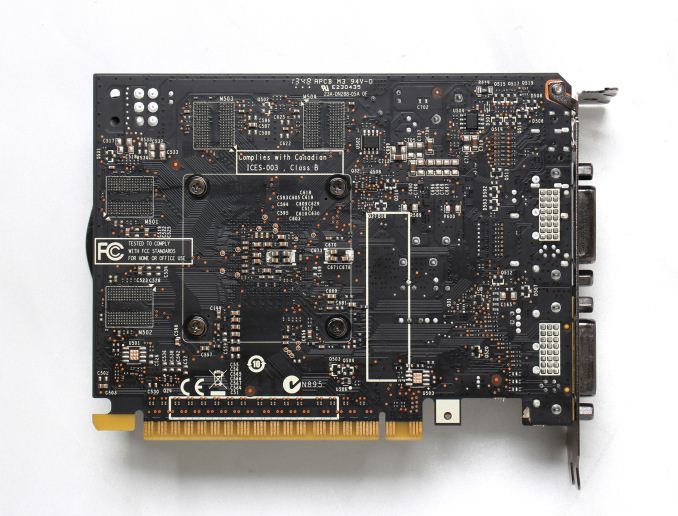 Speaking of RAM, looking at the Zotac GTX 750 we can get an idea of what to expect for RAM on a GTX 750 card. Zotac is using a 4x32bit configuration of Hynix H5GC2H24BFR-T2C, an interesting 2Gb module that can run at either 6GHz at normal voltages (1.5v), or 5GHz at low voltages (1.35v). We’re not able to tell which voltage mode Zotac is using, but given the configuration we wouldn’t be surprised to see them using 1.35v for extra power savings. Otherwise this means that the RAM on this card is significantly overpowered, which would be good for memory overclocking.
Speaking of RAM, looking at the Zotac GTX 750 we can get an idea of what to expect for RAM on a GTX 750 card. Zotac is using a 4x32bit configuration of Hynix H5GC2H24BFR-T2C, an interesting 2Gb module that can run at either 6GHz at normal voltages (1.5v), or 5GHz at low voltages (1.35v). We’re not able to tell which voltage mode Zotac is using, but given the configuration we wouldn’t be surprised to see them using 1.35v for extra power savings. Otherwise this means that the RAM on this card is significantly overpowered, which would be good for memory overclocking.
Meanwhile since Zotac’s PCB is identical to NVIDIA’s reference PCB, the I/O options are also the same: 1 DL-DVI-I port, 1 DL-DVI-D port, and a mini-HDMI port. Zotac tells us that they will also be releasing an OC edition card alongside these entry level cards, and that OC card will have a DisplayPort in order to be G-Sync ready.
Rounding out the package is the usual collection of a DVI-to-VGA adapter, Zotac’s “Boost Premium” OEM trialware, and the obligatory quickstart guides. Since these are entry level cards Zotac is sticking to NVIDIA’s MSRPs, putting their GTX 750 Ti card at $149 and their GTX 750 card at $119. Meanwhile for the warranty Zotac is offering a base 2 year warranty, which can be extended to a 3 year warranty by registering the card within 30 days.


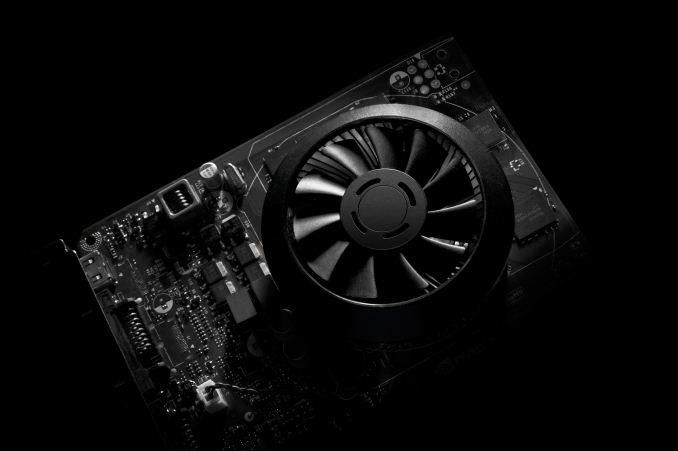
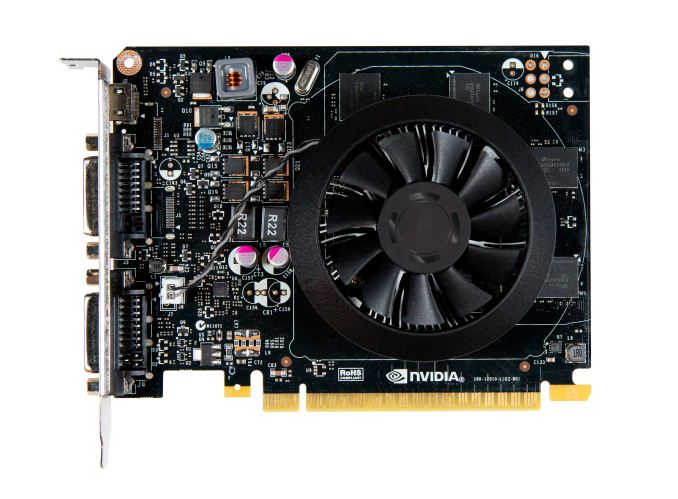
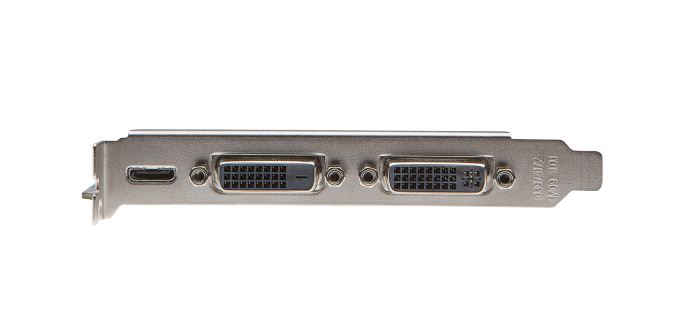

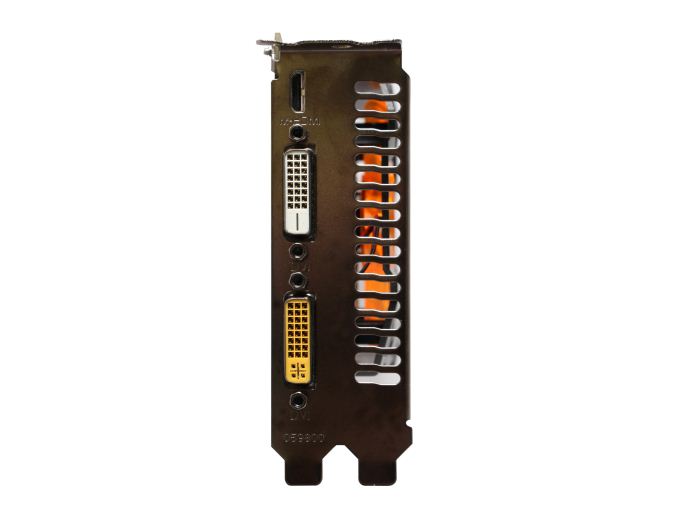








177 Comments
View All Comments
EdgeOfDetroit - Tuesday, February 18, 2014 - link
This card (Evga 750 Ti OC) is replacing a 560Ti for me. Its slower but its not my primary game machine anymore anyways. I'll admit I was kinda bummed when the 700 series stopped at the 760, and now that the 750 is here, its like they skipped the true successor to the 560 and 660. I can probably still get something for my 560Ti, at least.rhx123 - Tuesday, February 18, 2014 - link
I wonder if we'll get the 750Ti or even the 750 in a half height config.It would be nice for HTPCs given the power draw, but I'm not optimistic.
There's still nothing really decent in the half height Nvidia camp.
Frenetic Pony - Tuesday, February 18, 2014 - link
"it is unfortunate, as NVIDIA carries enough market share that their support (or lack thereof) for a feature is often the deciding factor whether it’s used"No this time. Both the Xbone and PS4 are fully feature compliant, as is GCN 1.1 cards, heck even GCN 1.0 has a lot of the features required. With the new consoles, especially the PS4, selling incredibly well these are going to be the baseline, and if you buy a NVIDIA card without it, you be SOL for the highest end stuff.
Just another disappointment with Maxwell, when AMD is already beating Nvidia price for performance wise very solidly. Which is a shame, I love their steady and predictable driver support and well designed cooling set ups. But if they're not going to compete, especially with the rumors of how much Broadwell supposedly massively improves on Intel's mobile stuff, well then I just don't know what to say.
Rebel1080 - Tuesday, February 18, 2014 - link
Can we all come to a consensus by declaring the 8th console generation an a epic bust!!! When the Seventh console generation consoles (PS3/XB360) made their debut it took Nvidia and AMD 12-18 months to ship a mainstream GPU that could match or exceed thier performance. This generation it only took 3 months at 2/3rds the price those cards sold at (3870/8800GT).It's pretty condemning that both Sony and MSFT's toy boxes are getting spanked by $119-149 cards. Worst of all the cards are now coming from both gpu companies for which I'm sure gives Nvidia all smiles.
FearfulSPARTAN - Tuesday, February 18, 2014 - link
Really an epic bust.... Come on now we all knew from the start they were not going to be bleeding edge based on the specs. They were not going for strong single threaded performance they were aiming for well threaded good enough cpu performance and the gpus they had were average at their current time. However considering the ps4 and x1 are selling very well calling the entire gen a bust already is just stupid. You dont need high performance for consoles when you have developers coding to scrape every bit of performance they can out of your hardware, thats something we dont have in the pc space and why most gamers are not using those cards that just met last gen console performance seven years ago.Rebel1080 - Tuesday, February 18, 2014 - link
They're selling well for the same reasons iTards keep purchasing Apple products even though they only offer incremental updates on both hardware and less on software. It's something I like to call "The Lemming Effect".Developers code to the metal but that only does so much and then you end up having to compromise the final product via lower res, lower fps, lower texture detail. Ironcially I was watching several YouTube videos of current gen games (BF3&4, Crysis 3, Grid 2, AC4) running at playable fps between 720p & 900P on a Radeon 3870.
oleguy682 - Tuesday, February 18, 2014 - link
Except that unlike Apple, Sony and Microsoft are selling each unit at a loss once the BOM, assembly, shipping, and R&D are taken into consideration. The PS3 was a $3 billion loss in the first two years it was available. The hope is that licensing fees, add-ons, content delivery, etc. will result in enough revenue to offset the investment, subsidize further R&D, and leave a bit left over for profit. Apple, on the other hand, is making money on both the hardware and the services.And believe it or not, there are a lot more console gamers than PC gamers. Gartner estimates that in 2012, PC gaming made up only $14 billion of the $79 billion gaming market. This does include hardware, in which the consoles and handheld devices (likely) get an advantage, but 2012 was before the PS4 and Xbone were released.
So while it might be off-the-shelf for this generation, it was never advertised as anything more than a substantial upgrade over the previous consoles, both of which were developed in the early 2000s. In fact, they were designed for 1080p gaming, and that's what they can accomplish (well, maybe not the Xbone if recent reports are correct). Given that 2160p TVs (because calling it 4K is dumb and misleading) are but a pipe dream for all but the most well-heeled of the world and that PCs can't even come close to the performance needed to drive such dense displays (short of spending $1,000+ on GPUs alone), there is no need to over-engineer the consoles to do something that won't be asked of them until they are near EOL.
Rebel1080 - Tuesday, February 18, 2014 - link
PC Gaming is growing faster globally than the console market because purchasing consoles in many nations is extremely cost prohibitive due to crushing tariffs. Figure that in 3yrs time both Intel and AMD will have IGPs that will trounce the PS4 and will probably sell for under $99 USD. PC hardware is generally much more accessible to people living in places like Brazil, China and India compared to consoles. It would actually cost less to build a gaming PC if you live there.The console market is the USA, Japan and Western Europe, as the economies of these nations continue to decline (all 3 are still in recession) people who want to game without spending a ton will seek lower cost alternatives. With low wattage cards like the 750Ti suddenly every Joe with a 5yr old Dell/HP desktop can now have console level gaming for a fraction of the cost without touching any of his other hardware.
Rebel1080 - Tuesday, February 18, 2014 - link
http://www.gamespot.com/articles/sony-says-brazil-...oleguy682 - Wednesday, February 19, 2014 - link
Brazil is only Brazil. It does not have any bearing on China or India or any other developing nation as they all choose their own path on how they tax and tariff imports. Second, throwing a 750Ti into a commodity desktop (the $800-1,200 variety) from 3 years ago, let alone 5, is unlikely to result in performance gains that would turn it into a full-bore 1080p machine that can run with the same level of eye-candy as a PS4 or XBone. The CPU and memory systems are going to be huge limiting factors.As far as the PC being a faster growing segment, the Gartner report from this fall thinks that PC gaming hardware and software will rise from the 2012 baseline of 18.3% of spending to 19.4% of spending in 2015. So yes, it will grow, but it's such a small share already that it barely does anything to move the needle in terms of where gaming goes. In contrast, consoles are expected to grow from 47.4% to 49.6% of spending. The losing sectors are going to be handheld gaming, eaten mostly by tablets and smartphones. PCs aren't dying, but they aren't thriving, regardless of what Brazil does with PS4 imports in 2014.